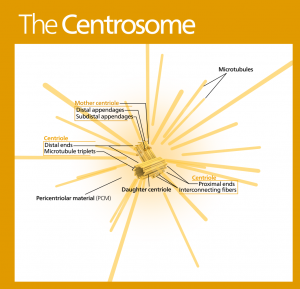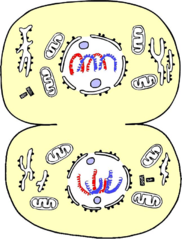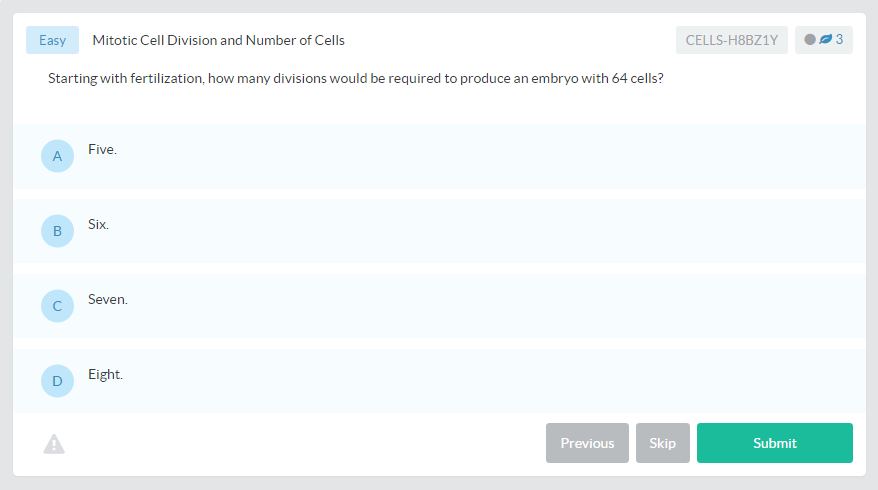As Baby Scorpions Grow Larger Which Process Occurs in Their Body Somatic Cells? Brainly
What is Mitosis?
In 1887, the German anatomy biologist, Water Fleming, coined the term mitosis which comes from the Greek language and translates to "wrap thread" from mitos and "act or process" from the osis function of mitosis. This term was based on the warped thread advent of the chromatin of the cell nucleus in the first stages of mitosis. Now, what is mitosis as a process? Mitosis is the procedure in prison cell division by which the nucleus of the jail cell divides (in a multiple phase), giving rise to two identical girl cells.
Mitosis happens in all eukaryotic cells (plants, animals, and fungi). It is the process of cell renewal and growth in a plant, animal or fungus. Information technology is continuously occurring throughout our bodies; it is even happening while you are reading this. Cells continuously dice; this process is termed apoptosis (programmed cell death). For yous to stay alive and fully functional, these cells demand to exist continuously replaced. Mitosis is crucial to this procedure. Mitosis is the reason nosotros can grow, heal wounds, and replace damaged cells.
Mitosis is also important in organisms which reproduce asexually: this is the only mode that these cells can reproduce. This is the one fundamental process that sustains populations of asexual organisms. Mitosis allows for some organisms to principal alternate life stages (asexual and sexual, such equally fungi).
The cardinal to mitosis occurring is the presence of a nucleus. Therefore, organisms without nuclei (prokaryotes) miss out on this impressive process.
Before Mitosis
Before mitosis begins, the chromosomes in the nucleus of the cell undergo replication. This is because mitosis produces 2 girl cells identical to the parent cell; so the number of chromosomes in the parent and daughter cells must be the aforementioned. Mitosis produces 2 diploid cells from one diploid cell. Thus, chromosome numbers must double before mitosis occurs. Continue in mind; diploid refers to the number of chromosomes in a cell: haploid cells have i fix of chromosomes (n), equally is found in a gamete (sex prison cell), whereas diploid cells have two sets of chromosomes (2n).
Overview of Mitosis
During mitosis, all chromosomes dissever into chromatids (the two halves of a chromosome). These chromatids are and then separated in space earlier cell division, to course the chromatic makeup of each daughter cell. Because there are double the number of diploid chromosomes in the parent cell (ii X 2n = 4n), when these chromosomes are separated into their chromatids and split into 2 groups, each group will have the same number of chromatids, and therefore chromosomes, as each other and every bit the parent cell. The composition of these chromosomes will also be identical. In one case the chromosomes are separated in infinite, cell sectionalization occurs to produce two daughter cells. Thus, mitosis uses chromosome replication to produce 2 identical diploid daughter cells, which are genetically identical to the diploid parent cell. This way all your cells have identical DNA composition.
The Phases of Mitosis
The process of mitosis tin be heed extraordinary to grasp fully; here we will try to work through it systematically. Offset off, mitosis can be dissever into 5 phases: Prophase, prometaphase, metaphase, anaphase and telophase. Some textbooks vary in the number of phases. In some instances they practice away with prometaphase and just keep the four fundamental phases.
What exactly happens in each phase of mitosis in animals may differ to what happens in plants. Nevertheless, all cells undergoing mitosis will in one fashion or some other undergo each of the in a higher place mentioned phases.
You will demand to familiarize yourself with the following terms to fully understand the phases of mitosis explained below:
| Cell furrow/cleavage furrow |  | The indentation found in the jail cell membrane of a recently divided animate being cell |
| Jail cell plate | The synthesized division of a found cell laid across the metaphase plate. This later forms the center lamella | |
| Centriole |  | An organelle associated with spindle cobweb production, located in the centrosome. These are only found in creature cells |
| Centrosome | The function of the cytoplasm which contains the centrioles | |
| Microtubules | Hollow poly peptide tubes which form spindle fibers (amid other things) | |
| Tubulin |  | The protein which makes up microtubules |
| Kinetochore microtubules |  | The microtubules which attach the centrosome to the kinetochore |
| Kinetochore | Plates of protein at a chromosome'southward centromere, to which spindle fibers attach during mitosis | |
| Centromere |  | The point of constriction of a chromosome |
| Cohesin |  | The protein which binds ii sister chromatids |
| Cytokinesis |  | Partitioning of the cytoplasm into two equal parts |
| Equatorial plane/metaphase plate |  | The midline of the prison cell forth which chromosomes align during metaphase |
| Interphase |  | The menses between mitosis occurrences; the period betwixt one telophase and the next prophase |
| Middle lamella |  | The cell construction between adjacent plant cell walls |
| Nuclear envelope |  | The double membrane which encloses the nucleus |
| Nucleolus | The center of rRNA production within the nucleus | |
| Sister chromatids |  | The two identical chromatids which grade a chromosome |
| Spindle fibers |  | A parcel of microtubules running from one pole of the cell to some other, along which chromosomes move |
Now that the definitions are out of the way permit us get started on the nitty gritty of this process.
1. Prophase
This is the longest phase of mitosis. Numerous important events occur in this phase, the centrioles migrate, the spindle fibers are organized, the nuclear envelope disintegrates, the nucleolus likewise disintegrates, and the chromatin fibers condense (Effigy ane).

Prophase in animal cells begins with the migration of two pairs of centrioles from just exterior the nucleus, in the centrosome, to polar ends of the cell. Once at polar ends of the cell, the centrioles promote the movement of microtubules from the cytoplasm into the spindle fibers. Plant and fungi cells practice not have centrioles; therefore, they skip this footstep.
While this is occurring, the nuclear envelope and nucleolus disintegrate, releasing the chromatin within. The chromatin condenses, and chromosomes go visible. The two chromatids making upwardly each chromosome are identical and are known equally sis chromatids. These are held together by cohesin.
Think of this phase this way, every role of the jail cell that is involved in mitosis changes to prepare for the full mitotic process. For case, at the end of mitosis the daughter cells demand equal amounts of identical DNA, so there has to exist a manner of making certain that the right contents go to the right jail cell. In other words, at that place has to be an insurance machinery for making sure that one cell does not end up with two copies of the one chromosome while the other cell ends up with nada copies of this chromosome. This is achieved through the hard work of spindle fibers which pull the contents of the one daughter jail cell to the one side while the other "half" is pulled towards the reverse end. This style, chromosomes never get lost and go to the wrong end. In brusk, things drift to their rightful corners.
The presence of the nuclear envelope limits how far chromosomes, in item, can get. And so before the jail cell tin consider pulling things autonomously and duplicating the contents, this barrier need to be removed somehow. This is why the nuclear envelope disintegrates.
If you follow the logic to a higher place it should be obvious why the other events occur. Read over the explanation presented below of the entire procedure and then get.
2. Prometaphase
Prometaphase is an intermediary phase between prophase and metaphase, here the cell is farther prepared for metaphase (effigy 2).

The spindle fibers attach to the kinetochore of each chromosome, at opposite sides of the centromere. Each sister chromatid is attached to its spindle fibers. These spindle fibers are comprised of kinetochore microtubules. The chromosomes migrate to the equatorial plane (or metaphase plate), which is perpendicular to the spindle fibers.
Here the same logic as in a higher place applies; information technology is all about making sure one chromatid ends upwardly in i jail cell.
iii. Metaphase
Metaphase refers to the alignment of the chromosomes at the equatorial plate following prometaphase.

Each centromere is aligned with the equatorial plate while the chromosome arms extend towards the poles. Each sister chromatid (still joined at this indicate) is on a unlike side of the equatorial plate (figure iii).
4. Anaphase
The Anaphase stage is the shortest phase of mitosis.

During this stage, disjunction occurs, and migration of sis chromatids abroad from each other to the poles of the jail cell occurs, leading to the formation of girl chromosomes.
Molecular motors use ATP to shorten the spindle fibers attached to each sister chromatid. In and so doing, the chromosomes are split into 2 genetically identical sis chromatids, known as girl chromosomes from this bespeak. This issue is known every bit disjunction. As the spindle fibers shorten further, the daughter chromosomes are drawn further apart until grouped at contrary ends of the jail cell.
There is now a diploid number of chromosomes at each pole.
5. Telophase
Telophase is the final phase of mitosis. After anaphase, ii diploid sets of chromosomes are located at each pole of the prison cell. Cytokinesis then occurs to split the cell into two identical daughter cells.

In animal cells, the cytoplasm is constricted to the point that the prison cell is divided in two. This results in a jail cell furrow. In plant cells, a cell plate is laid at the position of the equatorial aeroplane. This later becomes the heart lamella of the plant cell.
Following this, chromosomes are packed to go chromatin, a nucleolus reforms, and a nuclear envelope forms around the chromatin and nucleolus. The spindle fibers disappear, and the cell enters interphase.

Now that we have explored all the dissimilar stages go back reread and try to reason each upshot. This volition provide y'all with the ability to answer whatsoever questions near each and every one of these stages.
Why is Mitosis Of import?
Mitosis is of import for iii primary reasons: development and growth cell replacement and asexual reproduction.
1. Evolution and growth
After meiosis has produced a gamete, and this has fused with some other gamete to form an embryo, the embryo grows using mitosis. This growth continues throughout an organism'southward life, in plants, animals, and fungi. In this way, the original chromosomal set is preserved.
2. Cell replacement
This occurs when the original jail cell is damaged or wounded. New cells are created to replace those that were damaged. Examples of this are the healing of a cut or a cleaved bone. When old cells dice, new ones replace them to ensure continuing functionality.
3. Asexual reproduction
Single-celled organisms and certain multicellular organisms utilize mitosis for asexual reproduction. This includes reproduction by fragmentation, as in the case of planaria, and reproduction by budding, as in the case of bounding main anemones. Many plants reproduce using mitosis.
How is Mitosis Different from Meiosis?
First, we need to sympathize what meiosis is. Meiosis is the replication of cells that results in each daughter nucleus containing half of the parent cell's chromosomes. Meiosis is used primarily for the production of gametes, which are incorporated in sexual reproduction. Thus, the main divergence between mitosis and meiosis is that mitosis produces somatic (body) cells, which can become on to become part of whatsoever bodily tissue, whereas meiosis only produces germ (sexual practice) cells. Organisms which reproduce asexually cannot undergo meiosis, whereas all eukaryotic organisms undergo mitosis.
Mitosis and meiosis are similar in that both can just occur in eukaryotic cells. This is because prokaryotic cells do not comprise a nucleus within which to begin the processes of mitosis and meiosis. Instead, prokaryotes replicate themselves using binary fission. Both mitosis and meiosis begin with Dna replication in the parent cell to create 4 sets of chromosomes: in mitosis, these sets are divide to form two diploid daughter cells, while in meiosis, these sets are dissever to course four haploid daughter cells. This is because cells undergo just 1 division in mitosis, whereas they undergo two divisions in meiosis.
The table below summarizes the similarities and differences between mitosis and meiosis.
Mitosis | Meiosis |
Similarities | |
| Tin can but occur in eukaryotes | |
| Dna replication occurs first | |
| Production of daughter cells based on parent cell's genetic fabric | |
| Means of cell replication in plants, animals, and fungi | |
Differences | |
| Starts as diploid; ends every bit diploid | Starts as diploid; ends as haploid |
| Used for growth/healing/asexual reproduction | Used for sexual reproduction |
| 1 nuclear division | two nuclear divisions |
| 5 phases | eight phases |
| Daughter cell identical to parent prison cell | Girl cell non identical to parent jail cell |
| Results in 2 girl cells | Results in 4 daughter cells |
| Produces somatic cells | Produces germ cells |
| Occurs in asexual and sexual organisms | Occurs only in sexual organisms |
Wrapping Upwards Biological science and Mitosis
Nosotros now know that mitosis is the process of asexual cell replication that is responsible for an organism'due south evolution and growth, its cell replacement, and also, in certain organisms, asexual reproduction. Mitosis is, therefore, an integral part of eukaryotic functioning. Mitosis differs from meiosis in that meiosis is the product of gametes, or sex cells, which will allow for genetic recombination in sexual organisms. However, without mitosis, the embryos formed will never grow to become organisms. Mitosis is preceded past Dna replication, to class two diploid sets of chromosomes. Mitosis has five phases. The first stage is prophase, where the chromatic material is released from the nucleus, and centromeres migrate to the poles of the cell. Prophase is followed past prometaphase, where the chromosomes migrate to align at the equatorial plane of the jail cell. The third phase is metaphase, where the chromosomes are fully aligned at the equatorial plane. Metaphase is followed by anaphase, wherein the sister chromatids forming each chromosome are pulled autonomously to assemble at the poles of the cell; and telophase, where cytokinesis forms 2 identical daughter cells, genetically identical to the parent jail cell. Following this, the cell enters interphase, the stage between mitosis events.
Mitosis has given eukaryotic organisms the ability to regenerate cells equally necessary without reducing the chromosome set up while meiosis has allowed the possibility of genetic recombination. Both are vital for the prevalence and continued survival of eukaryotic organisms.
Allow's put everything into practice. Try this Biology practice question:
 Looking for more Biology practice?
Looking for more Biology practice?
Check out our other articles on Biological science.
You tin as well find thousands of do questions on Albert.io. Albert.io lets you customize your learning experience to target practise where you need the most assistance. We'll give y'all challenging exercise questions to assist you achieve mastery in Biological science.
Start practicing here .
Are you a teacher or administrator interested in boosting Biology student outcomes?
Learn more virtually our school licenses here.
davenportwhictime.blogspot.com
Source: https://www.albert.io/blog/what-is-the-purpose-of-mitosis/
Publicar un comentario for "As Baby Scorpions Grow Larger Which Process Occurs in Their Body Somatic Cells? Brainly"